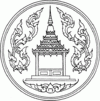Uttaradit Province (Changwat Uttaradit)
 |
Uttaradit means the "port of the north" or "northern landing", as it was formerly a trade center on the Nan River.
In the Sukhothai era several city states (Mueang) subject to the king were in the area of the modern province. Mueang Fang was in modern-day Mueang Uttaradit district, Mueang Thung Yang in Laplae, and Mueang Ta Chuchok in Tron district.
During the Ayutthaya kingdom, Mueang Phichai was one of the 16 main Mueang of the Thai kingdom. In the reign of King Naresuan, the ruler of Phichai rebelled, joined by the ruler of the Sawankhalok region. Their revolt was suppressed and the inhabitants of both cities were forced to move south to Phitsanulok.
Following the fall of the city of Ayutthaya to the Burmese in 1767, Phichai was the site of several battles against the invaders. The ruler of Phichai succeeded in driving back the Burmese and was awarded the title Phraya Phichai Dap Hak - the "Lord of Pichai with a Broken Sword", as he had broken one of his swords in fierce hand-to-hand combat with the enemy.
In the reign of King Rama III Mueang Phichai controlled several Mueang of northern Siam like Nan or Phrae, and even Luang Prabang and Vientiane. At the point where the Nan river became shallow a port was established. As this town grew in importance as an important trade point, in 1887 it was made a Mueang subordinate of Phichai. 1899 the center of Phichai was moved to this new location, which was renamed to Uttaradit in 1915.
Map - Uttaradit Province (Changwat Uttaradit)
Map
Country - Thailand
 |
 |
| Flag of Thailand | |
Tai peoples migrated from southwestern China to mainland Southeast Asia from the 11th century. Indianised kingdoms such as the Mon, Khmer Empire and Malay states ruled the region, competing with Thai states such as the Kingdoms of Ngoenyang, Sukhothai, Lan Na and Ayutthaya, which also rivalled each other. European contact began in 1511 with a Portuguese diplomatic mission to Ayutthaya, which became a regional power by the end of the 15th century. Ayutthaya reached its peak during the 18th century, until it was destroyed in the Burmese–Siamese War. Taksin quickly reunified the fragmented territory and established the short-lived Thonburi Kingdom. He was succeeded in 1782 by Buddha Yodfa Chulaloke, the first monarch of the current Chakri dynasty. Throughout the era of Western imperialism in Asia, Siam remained the only nation in the region to avoid colonization by foreign powers, although it was often forced to make territorial, trade and legal concessions in unequal treaties. The Siamese system of government was centralised and transformed into a modern unitary absolute monarchy in the reign of Chulalongkorn. In World War I, Siam sided with the Allies, a political decision made in order to amend the unequal treaties. Following a bloodless revolution in 1932, it became a constitutional monarchy and changed its official name to Thailand, becoming an ally of Japan in World War II. In the late 1950s, a military coup under Field Marshal Sarit Thanarat revived the monarchy's historically influential role in politics. Thailand became a major ally of the United States, and played an anti-communist role in the region as a member of the failed SEATO, but from 1975 sought to improve relations with Communist China and Thailand's neighbours.
Currency / Language
| ISO | Currency | Symbol | Significant figures |
|---|---|---|---|
| THB | Thai baht | ฿ | 2 |
| ISO | Language |
|---|---|
| EN | English language |
| TH | Thai language |















